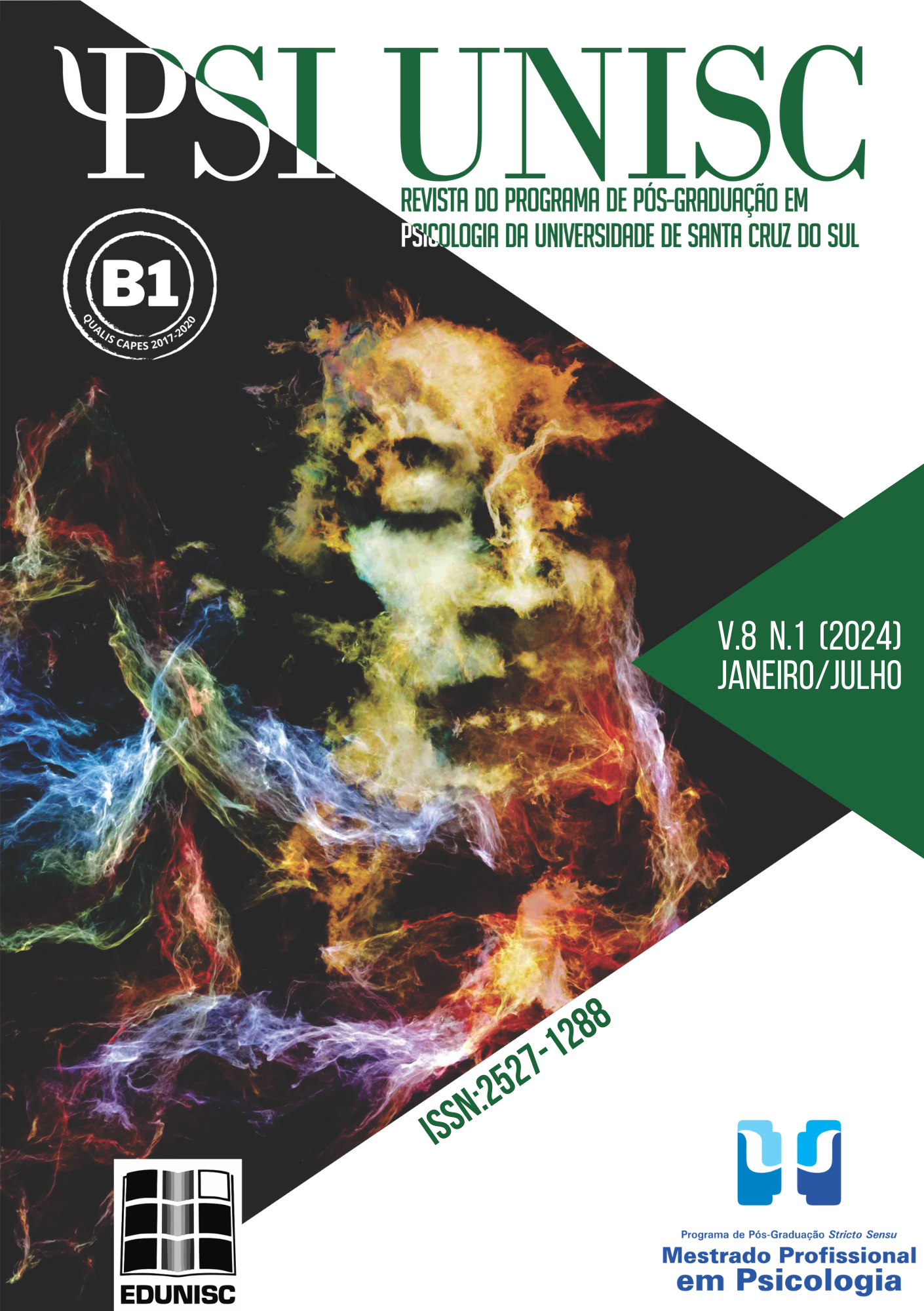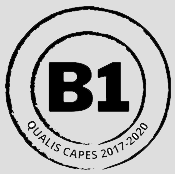Group psychosocial intervention with adolescents that have committed sexual offense
DOI:
https://doi.org/10.17058/psiunisc.v8i1.18467Keywords:
Sexual offense, Adolescence, Psychosocial interventionAbstract
This text presents a group psychosocial intervention proposal with adolescents that have committed sexual offenses and characterized by family intervention perspective (Multifamily Group). In addition to the demand for care for adolescents aged 12 to 15 years old that have committed a sexual offense, the inclusion of the age group from 16 to 18 years has been observed. These two age groups, 12-15 and 16-18, present different characteristics in relation to the violence suffered in their short life histories, as well as the severity of the violence committed. The proposal developed was made up of seven sessions of three hours each, with predefined themes that have targeted interventions for participants according to their age: children, adolescents and adults. Each session was organized into three moments: warm-up, discussion of the topic and conclusion. The intervention method included ludic activities and some psychodramatic resources adapted to adolescents of both age groups and their families. This text is descriptive and reports an intervention adapted to the context of adolescents in these age groups and their families, based on broader action-research. The possibilities of the proposal are discussed, based on the observations of professionals that have conducted the intervention, together with information present in the literature about sexual offenses committed by adolescents. The need for future studies that deepen about the topic of adolescents and young adults that committed sexual offense is emphasized, considering the specificities of these age groups. The limits of the proposal and the challenges in its applicability are also indicated.
Downloads
References
Alexander, A. A., McCallum, K. E., & Thompson, K. R. (2021). Poly-victimization among adolescents adjudicated for illegal sexual behavior: A latent class analysis. Journal of Aggression, Maltreatment & Trauma, 30(3), 347-367. https://doi.org/10.1080/10926771.2020.1774692
Andolfi, M. (1981). A Terapia Familiar. Vega.
Andolfi, M. (2018). A terapia familiar multigeracional. Instrumentos e recursos do terapeuta. Artesã Editora.
Andolfi, M., & Mascellani, A. (2014). Historias de la adolescência. Gedisa.
Barbier, R. (2002). A pesquisa-ação. Liber Livro.
Bastos, K. R. P., & Costa, L. F. (2020). O adolescente autor de ofensa sexual: da denúncia à responsabilização jurídica. Estudos Interdisciplinares em Psicologia, 11(2), 76-97. http://www.uel.br/revistas/uel/index.php/eip/article/view/76/27987
Bastos, K. R. P., Eusébio, A. M. L., Pereira, K. N. D. A., Silva, T. O. S. D., & Costa, L. F. (2021). Características dos adolescentes ofensores sexuais e de suas vítimas: um estudo de processos judiciais. Saúde e Sociedade, 30(1), 1-13. https://doi.org/10.1590/S0104-12902021181112
Blackley, R., & Bartels, L. (2018). Sentencing and treatment of juvenile sex offenders in Australia. Australian Institute of Criminology. Trends & issues in crime and criminal justice, (555), 1-15. https://ssrn.com/abstract=3340975
Borges, M. M. & Costa, L. F. (2023). Transgeracionalidade de adolescentes que praticaram ofensa sexual: Estrutura Familiar, Lealdade, Delegação. Nova Perspectiva Sistêmica, 32(75), 74-90. https://www.doi.org/10.38034/nps.v32i75.689
Borges, M. M., & Costa, L. F. (2020). Adolescentes ofensores sexuais atendidos em uma instituição de saúde do Centro-Oeste do Brasil. Arquivos Brasileiros de Psicologia, 72(1), 140-158. http://dx.doi.org/10.36482/1809-5267.ARBP2020v72i2p.140-158
Brasil. (1940). Decreto-Lei nº 2.848, de 7 de dezembro de 1940. Código Penal Brasileiro. http://www.planalto.gov.br/ccivil_03/decreto-lei/Del2848.htm
Brasil. (1990). Lei nº 8.069, de 13 de julho de 1990. Estatuto da Criança e do Adolescente. http://www.planalto.gov.br/ccivil_03/leis/l8069.htm
Brasil. (2013). Plano Nacional de Enfrentamento da Violência Sexual contra Crianças e Adolescentes. http://www.crianca.mppr.mp.br/arquivos/File/publi/sedh/08_2013_pnevsca.pdf
Conceição, M. I. G., Penso, M. A., Costa, L. F., Setubal, C. B., & Wolff, L. S. (2018). O psicodrama na intervenção psicossocial com adulto autor de violência sexual. In: Habigzang, L. F., Gomide, P. I. C. & Rocha, G. M. (Eds.), Psicologia Forense. Temas e Práticas (pp.89-110). Juruá.
Costa, L. F., & Penso, M. A. (2010). O grupo multifamiliar nas situações de violência sexual contra crianças e adolescentes. Em C. Ladvocat (Org.), Psicologia: campo de atuação, teoria e prática. São Paulo: Book Link.
Costa, L. F., Junqueira, E. L., Bastos, K. R. P., & Tavares, A. S. (2020b). O que fazer? Ofensa sexual cometida por pré-adolescentes e adolescentes dos gêneros masculino e feminino. In: Amparo, D., Lazzarini,E. R., Brasil, K. C. T. & Arouca, R. (Eds). Adolescência. Psicoterapia e mediação terapêutica na clínica dos extremos (pp. 339-355). Technopolitik
Costa, L. F., Junqueira, E. L., Meneses, F. F. F., & Ströher, L. M. C. (2013). As relações familiares do adolescente ofensor sexual. Psico-USF, 18(1), 33-44. https://doi.org/10.1590/S1413-82712013000100005
Costa, L. F., Penso, M. A., & Conceição, M. I. G. (2015). Manual de Grupos Multifamiliares. Central de Produções Gráficas e Editora.
Costa, L. F., Penso, M. A., Santos, S. R. M. L. B., & Moura, M. G. (2020a). Atuação sistêmica na comunidade: O grupo multifamiliar no contexto do adolescente que cometeu ofensa sexual. In J. A. A. Mendes & J. B. N. F. Bucher-Maluschke (Eds.), Perspectiva sistêmica e práticas em psicologia: temas e campos de atuação (pp. 207-224). Editora CRV.
Costa, Liana F. (2022, maio, 28). Possibilidades de intervenção frente às violências: um enfoque sistêmico para a ação psicossocial com a família, a vítima e o ofensor. [Arquivo PowerPoint de apoio à apresentação de disciplina em curso online de Estudos Avançados em Práticas Sistêmicas, Aprender Vivo].
Costa, Ribeiro, Junqueira, Meneses, & Ströher (2011). Grupo multifamiliar com adolescentes ofensores sexuais. Psico, 42(4), 450-456. https://scholar.google.com.br/scholar?hl=pt-BR&as_sdt=0%2C5&q=Grupo+multifamiliar+com+adolescentes+ofensores+sexuais.+Psico%2C+42%284%29%2C+450-456&btnG=
Creswell, J. W., & Creswell, J. D. (2021). Projeto de pesquisa: Métodos qualitativo, quantitativo e misto. Penso Editora.
Debona, T. L., Teixeira, A. N., Lima, D. J. M., Neto, M. L., & Gontijo, R. C. (2018). O outro lado da história: Um olhar sistêmico sobre os ofensores sexuais intrafamiliares. Revista Interdisciplinar Pensamento Científico, 4(3), 130–138. http://dx.doi.org/10.20951/2446-6778/v4n3a13
DeKeseredy, W. S., Schwartz, M. D., Nolan, J., Mastron, N., & Hall-Sanchéz, A. (2019). Polyvictimization and the Continuum of Sexual Abuse at a College Campus: Does Negative Peers Support Increase Likelihood of Multiple Victimizations? British Journal of Criminology, 59(2), 276-295. https://doi.org/10.1093/bjc/azy036
Diniz, D., Brito, L., Rondon, G., & Gumeri, S. (2017). Proteção constitucional à infância e à adolescência: uma crítica à redução da maioridade penal. In A. P. de Andrade & B. A. Machado (Eds.), Justiça Juvenil. Paradigmas e experiências comparadas (pp. 95-106). Marcial Pons, Fundação Escola Superior do Ministério Público do Distrito Federal e Territórios (FESMPDFT).
Domingues, D. F., & Costa, L. F. (2016). O adolescente em situação de ofensa sexual: proteção e responsabilização para evitar a reincidência. Psicologia Política, 16(35), 139-151. http://pepsic.bvsalud.org/pdf/rpp/v16n36/v16n36a02.pdf
Eastman, O., Craissati, J., & Shaw, J. (2019). Young adult sexual offenders with emerging personality disorders: developmental and offence-related characteristics and treatment engagement. Journal of sexual aggression, 25(2), 105-115. https://doi.org/10.1080/13552600.2018.1551501
Henggeler, S. W., Letourneau, E. J., Borduin, C. M., Schewe, P. A., & Mccart, M. R. (2009). Mediators of Change for Multisystemic Therapy with Juvenile Sexual Offenders. Journal of Counsulting and Clinical Psychology, 77(3), 451-462. http://dx.doi.org/10.1037/a0013971
Hollander, E. M., & Craig, M. (2013). Working with Sexual Offender via Psychodrama. Sexual Offender Treatment, 8(2), 1-15. http://www.sexual-offender-treatment.org/index.php?id=124&type=123
Kettrey, H. H., & Lipsey, M. W. (2018). The effects of specialized treatment on the recidivism of juvenile sex offenders: a systematic review and meta-analysis. Journal of Experimental Criminology, 14(3), 361-387. https://doi.org/10.1007/s11292-018-9329-3
Marshall, W. L. (2018). A brief history of psychological theory, research, and treatment with adult male sex offenders. Current Psychiatry Reports, 20(8), 1-8. https://doi.org/10.1007/s11920-018-0920-0
Marra, M. M., & Costa, L. F. (2018). Entre a revelação e o atendimento: família e abuso sexual. Avances en Psicologia Latinoamericana, 36(3), 459-475. https://doi.org/10.12804/revistas.urosario.edu.co/apl/a.3564
McGoldrick, M., Gerson, R., & Petry, S. (2012). Genogramas: Avaliação e intervenção familiar. Artmed.
McKillop, N. (2019). Understanding the nature and dimensions of child sexual abuse to inform its prevention. In India, B., Yolande, R., & Patherick, W. (Eds.), Child Abuse and Neglect (pp. 241–259). Academic Press.
Minuchin, S., Nichols, M. P. & Lee, W-Y. (2009). Famílias e Casais: do sintoma ao sistema. Artmed.
Moreno, J. L. (1984). Psicodrama. Cultrix.
Moreno, J. L., & Moreno, Z. T. (2014). Fundamentos do psicodrama. Ágora.
Musicaro, R. M., Spinazzola, J., Arvidson, J., Swaroop, S. R., Grace, L. G., Yarrow, A., Suvak, M. K., & Ford, J. D. (2017). The Complexity of Adaptation to Childhood Polyvictimization in Youth and Young Adults: Recommendations for Multidisciplinary Responders. Trauma, Violence, & Abuse, 20(1), 81-98. https://doi.org/10.1177/1524838017692365
Penso, M. A., Conceição, M. I. G., Costa, L. F., & Carreteiro, T. C. O. (2012). Jovens pedem socorro. O adolescente que praticou ato infracional e o adolescente que cometeu ofensa sexual. Liber Livro.
Pullman, L. E., Leroux, E. J., Motayne, G., & Seto, M. C. (2014). Examining the developmental trajectories of adolescent sexual offenders. Child abuse & Neglect, 38(7), 1249–1258. https://doi.org/10.1016/j.chiabu.2014.03.003
Ryan, E. P., & Otonichar, J. M. (2016). Juvenile sex offenders. Current psychiatry reports, 18(7), 67. https://doi.org/10.1007/s11920-016-0706-1
Said, A. P., & Costa, L. F. (2019). Family Dinamics of Boys Victims of Sexual Abuse. Paideia, 29, e2908. http://dx.doi.org/10.1590/1982-4327e2908
Sandvik, M., Nesset, M. B., Berg, A., & Søndenaa, E. (2017). The Voices of Young Sexual Offenders in Norway: A Qualitative Study. Open Journal of Social Sciences, 5, 82-95. https://doi.org/10.4236/jss.2017.52009
Seto, M. C., Babchishin, K. M., Pullman, L. E., & McPhail, I. V. (2015). The puzzle of intrafamilial child sexual abuse: A meta-analysis comparing intrafamilial and extrafamilial offenders with child victims. Clinical Psychology Review, 39, 42-57. https://doi.org/10.1016/j.cpr.2015.04.001
Silva, A. C. G., Fernandez, L. M. M., Sousa, R. G. C., Pereira, V. M., Tavares, A. S., & Costa, L. F. (2021). Avaliação de reincidência de ofensa sexual cometida por adolescentes de 16-18 anos. Desidades, 9(31), 188-206. http://dx.doi.org/10.54948/desidades.voi31.41471
Sterzing, P. R., Fisher, A. J., & Gartner, R. E. (2019). Familial pathways to polyvictimization for sexual and gender minority adolescents: Microaffirming, microaggressing, violent, and adverse families. Psychology of Violence, 9(4), 461–470. https://doi.org/10.1037/vio0000224
Stewart, S., Toohey, A., & Lapshina, N. (2020). Childhood maltreatment and risk of harm to self and others: The role of sex and polyvictimization. International Journal of Child and Adolescent Resilience (IJCAR), 7(1), 108-122. https://doi.org/10.7202/1072592ar
Tavares, A. S., & Montenegro, N. M. S. (2019). Intervenção Psicossocial com Adolescentes que Cometeram Ofensa Sexual e suas Famílias: O Grupo Multifamiliar. Nova Perspectiva Sistêmica, 64, 82-104. https://doi.org/10.38034/nps.v28i64.500
Tavares, A. S., Costa, L. F., & Moreira, D. L. (2021). Ofensa sexual cometida por adolescentes jovens/adultos. Aletheia, 54(2), 82-94. http://www.periodicos.ulbra.br/index.php/aletheia/issue/view/363
Tavares, A. S., Setubal, C. B., Montenegro, N. M. S., Moreira, D. L., & Costa, L. F. (2020). Atenção ao adolescente/jovem adulto que cometeu ofensa sexual: um problema complexo e interdisciplinar. In E. Lazzarini, M. Maesso, P. Costa, & S. Oliveira (Orgs.), Psicologia Clínica e Cultura Contemporânea 5 (pp. 393-411). Curitiva: CRV. https://psicc.unb.br/images/livros/LivroPsiCC5.pdf
Webster, G. (2018). Psychoanalytic Complex Theory: An Aplication to the Treatment of Child Sexual Offenders. Psychoanalytic Psychology, 35(1), 83-92. http://dx.doi.org/10.1037/pap0000120
Wolff, L. D. S., Oliveira, E. S. D., Marra, M. M., & Costa, L. F. (2016). O recurso psicodramático na intervenção com o adulto autor de ofensa sexual. Revista Brasileira de Psicodrama, 24(2), 58-68. http://dx.doi.org/10.15329/2318-0498.20160020
Worling, J. R., & Langton, C. M. (2016). Treatment of Adolescents Who Have Sexually Offended. In L. Marshall. & W. Marshall (Orgs.), The Wiley Handbook on the Theories, Assessment, and Treatment of Sexual Offending (pp. 1245-1263). John Wiley. https://doi.org/10.1002/9781118574003.wattso057
Yoder, J. R., Hodge, A. I., Ruch, D., & Dillard, R. (2019). Effects of childhood polyvictimization on victimization in juvenile correctional facilities: The mediating role of trauma symptomatology. Youth violence and juvenile justice, 17(2), 129-153. https://doi.org/10.1177/1541204018757038
Downloads
Published
How to Cite
Issue
Section
License
The submission of originals to this journal implies the transfer, by the authors, of the printed and digital publication rights. The copyrights for the published articles are those of the author, with periodical rights on the first publication. Authors may only use the same results in other publications clearly indicating this journal as the medium of the original publication. Because we are an open access journal, we allow free use of articles in educational and scientific applications provided the source is cited under the Creative Commons CC-BY license.




